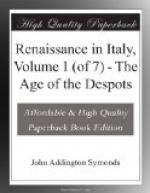The struggle carried on between the Popes of the thirteenth century and the House of Hohenstauffen ended in the elevation of the Princes of Anjou to the throne of Naples—the most pernicious of all the evils inflicted by the Papal power on Italy. Then followed the French tyranny, under which Boniface VIII. expired at Anagni. Benedict XI. was poisoned at the instigation of Philip le Bel, and the Papal see was transferred to Avignon. The Popes lost their hold upon the city of Rome and upon those territories of Romagna, the March, and S. Peter’s Patrimony which had been confirmed to them by the grant of Rodolph of Hapsburg (1273). They had to govern their Italian dependencies by means of Legates, while, one by one, the cities which had recognized their sway passed beneath the yoke of independent princes. The Malatesti established themselves in Rimini, Pesaro, and Fano; the house of Montefeltro confirmed its occupation of Urbino; Camerino, Faenza, Ravenna, Forli, and Imola became the appanages of the Varani, the Manfredi, the Polentani, the Ordelaffi, and the Alidosi.[1] The traditional supremacy of the Popes was acknowledged in these tyrannies; but the nobles I have named acquired a real authority, against which Egidio Albornoz and Robert of Geneva struggled to a great extent in vain, and to break which at a future period taxed the whole energies of Sixtus and of Alexander.
[1] See Mach. Ist. Fior. lib. i.




